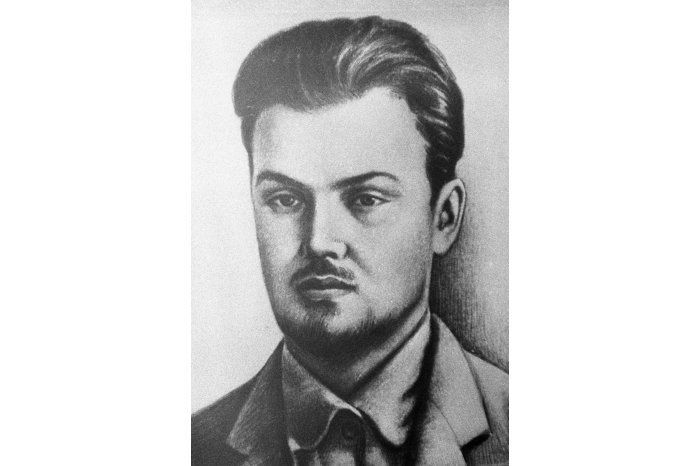Serghei Lazo, legendary name that needs to be rehabilitated
10:21 | 02.06.2021 Category:
The Russian revolutions and the civil war that followed highlighted several Bessarabian personalities who made a title of glory through his courage and talents. Most of them came to the revolution from the conjuncture, some even being pardoned by the Bolsheviks for serious criminal acts in the past. Serghei Lazo is a special personality, a man of a rare culture and innocence, brought almost to the point of absurdity.
Serghei Lazo was born in a family with deep noble roots, attested still in the time of Alexandru cel Bun. The correct name was Lazu, and in different generations the representatives of this family held the positions of high rulers at the royal courts. At the time of Serghei's birth, the Lazo family had three estates: Piatra near Orhei, Ezăreni near Bălți and a fortune in Poland.
Namely in Piatra, in 1894, Serghei was born. The godparents were Gheorghe Catargiu, a royal cupbearer, with an estate in the neighboring village, Păhărniceni and Nicolae Alexandri, a confidant of the great Russian writer Lev Tolstoy, the first editor of the first Romanian-language newspaper in Bessarabia, published after the tsarist manifesto, who was forced to give some rights to the peoples of the Russian Empire under the pressure of the first Russian revolution. Nicolae Alexandri was the senior dean of the Country Council and opened his works.
Sergei's grandmother, Matilda Lazo, was of Swiss origin and the daughter of the famous Mrs. Eihfeld, to whom Alexandr Pushkin dedicated an admiring poem. The tomb of Matilda Lazo, as well as that of grandfather Ioan and father Gheorghe is next to that of Matilda in the courtyard of the church in Piatra.
There were kinship ties with the families of the writers Donici and Russo, and among the closest friends were nobles Gore, Suruceanu, the famous doctor Toma Ciorbă and other Bessarabian personalities. In the diary, Serghei confesses that he was in love with Tasea Gore, the daughter of the legendary heraldist Paul Gore, and in Petersburg he insistently courted Mila Suruceanu, the daughter of the Bessarabian deputy in the State Duma.
In the first stage, the young Serghei received education at home, in Piatra. Teachers from Orhei and Chisinau came here. After the death of his father, Gheorghe Lazo, the family moved for a short time to Ezăreni, then his mother Elena Crușevan, a noblewoman who became famous in Bessarabia during the interwar period, bought a house in Chisinau to provide quality education to her three sons: Serghei , Boris and Stefan.
From the testimonies of the time, but also from Serghei's splendid diary, we deduce that he was a young man with exceptional abilities, without exaggeration. He could easily read texts in ancient Greek, Latin, English, Russian and Romanian. He had a literary style that some writers might envy. There was also a rich library in the house, in which the works of Eminescu, Alecsandri, Russo, purchased from Iași, occupied a leading place. He was passionate about the exact sciences, studied German philosophy, read in original the great English poets.
He was first attracted to the imperial capital, Petersburg. Here he studied at the Institute of Technology, once founded by the great scientist Mendeleev.
In Petersburg he met several personalities, some of them with revolutionary visions.
A transfer to the University of Moscow follows, but World War I begins and Lazo is enrolled in the officer school. The military service in Siberia follows, from where he writes long and longing letters about Bessarabia, for his mother and brothers, he greets Romania's entry into the war on the side of the Entente. In the middle of the February revolution, he became a member of the internationalist faction. In a short time he makes a lightning career. At just 24, he became commander of the Transbaikalia Front, commander of the Far Eastern partisan movement, founder and president of the Far Eastern Republic. From here on, the mystery begins in the biography of Sergei Lazo.
In Transbaikalia and the Far East, Serghei Lazo was extremely popular, even legendary. About him there are a lot of popular ballads known to this day. Probably to confiscate this legend, Moscow published the testimonies of Bocikariov's bandits, taken prisoner in Kamchatka in 1926, who allegedly testified that they saw the Japanese throw the three leaders of the republic into the hearth of a locomotive. Immediately, a famous poem by Vladimir Mayakovsky appears, which gives the propagandistic signal that Sergei Lazo was a Bolshevik revolutionary killed by the Japanese. Gradually, this theory, which has no documentary coverage, became popular in the consciousness of several Soviet generations.
The mansion of the Lazo family in Piatra has been somehow preserved. The authors of the project were able to see what the mansion looked like in a panoramic photograph taken in 1891, but they neglected it. There is also a monstrous monument in the Botanica sector due to its ugliness, built in the 80s of the last century. In the courtyard of the Medical University is also the house of the Lazo family from Chisinau. Sergei Lazo's daughter, Ada, lived in Leningrad and dedicated her life to archival investigations. He also edited Serghei Lazo's diary, which, unfortunately, was brutally falsified by Soviet censorship.
It is unfortunate that after 1990 no one wanted or could not rehabilitate the good name of a Bessarabian personality, which certainly ennobles our nation and increases the national treasure. No one needed an original biography of a famous compatriot. Such efforts are outdated today and they do not help a career and do not generate material goods.

